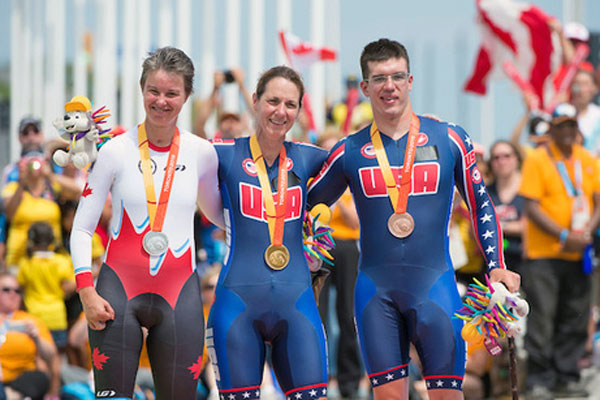On a tricycle, Shelley Gautier (BPST 1995) is the world’s fastest woman. She’s a ten-time Paracycling Road World Champion (including the two golds she won just last week in Switzerland). A silver medallist last time the Parapan Am Games were held, she’s going for the top of the podium when this year’s Games begin in Toronto.
But Gautier, 47, is about much more than gold and glory – she’s dedicating her life to helping others find happiness through sport. Through her Shelley Gautier Para-Sport Foundation, she’s actively working to make sports more accessible, and to create programs – around the world – in which people with a disability can not only play the games they love, but work as coaches, trainers and in related jobs.
It’s about more than fitness. “I want people with disabilities to be involved in their community, ,” she says. “They can do something good for other people. And we can get people with disabilities employed so we can do good for them as well.”

Gautier first took up disabled sailing, then switched to cycling. She competes in the T1 tricycle class – the extra wheel provides assistance with balance. Hemiplegia affects not just the physical race but also her strategy. “I have some motion in my right leg,” she explains, “so I’m pedalling with both but less my one side. Steering is challenging. I have brakes and gears on my left side of my handlebar because [although] I am able to grab the handlebar with my right hand, I can’t do much with it. Because all the steering is done with my left hand, right turns can be difficult. I can’t go narrow, I have to make a big sweep.”
Gautier, who has a physiotherapy degree from U of T, stayed involved with her alma mater for many years. She taught anatomy as a teaching assistant for the department of occupational science and occupational therapy. (In November, Shelley will be awarded the 2015 University of Toronto, Physical Therapy and Occupational Therapy Alumni Association Above & Beyond Award.) Along with competing, it’s good background for understanding why physical fitness is especially healthy for people with disabilities – linked to better physical health and increased happiness.
Gautier knows how happiness and racing are connected. “Feels good [to be racing]!” she says. “I really want to win.” A favourite memory is winning the world championships: “Being first and having somebody pass me and then pass them, you know, it’s just very nice,” she smiles.

Photo: Phillip MacCallum/Canadian Paralympic Committee
The Shelley Gautier Foundation’s first project was to organize a recreational paracycling program this summer in Hamilton, Ontario, where athletes were provided with equipment and six weeks of paid coaching. The Foundation plans to take para-cycling into schools and create programs for other sports, such as sailing and sledge hockey, too.
And then there’s Gautier’s plans for Kenya. She’s working with the Tegla Loroupe Peace Foundation to start a tandem riding program at a school for the blind that could eventually develop into an elite-level women’s paracycling team.
Why include elite sports as well as local programs? “Hopefully,” says Gautier, “people with disabilities can see me competing, and think that they can do it as well.” She’s found that being at the top level has helped her personally, despite the rigorous training schedule of five two-hour bike rides a week, and a weight routine all winter. “Competition has taught me that whatever I can do, I can do,” she says. “And I think that’s important for people to know, that if they have a goal that is realistic, they should go after it.”
Regardless of her place on the Parapan Am podium, Gautier has a lot to go after. She’s training for the Rio Olympics, and of course there is the foundation. “I wanted some legacy so that disabled people aren’t forgotten after the Parapan Ams,” she says, explaining why she launched the organization. With Gautier as a champion for parasport, it seems that spotlight will keep shining brightly.
Update: Gautier won the silver medal in the Parapan Am time trial race!

Recent Posts
U of T’s 197th Birthday Quiz
Test your knowledge of all things U of T in honour of the university’s 197th anniversary on March 15!
Are Cold Plunges Good for You?
Research suggests they are, in three ways
Work Has Changed. So Have the Qualities of Good Leadership
Rapid shifts in everything from technology to employee expectations are pressuring leaders to constantly adapt




